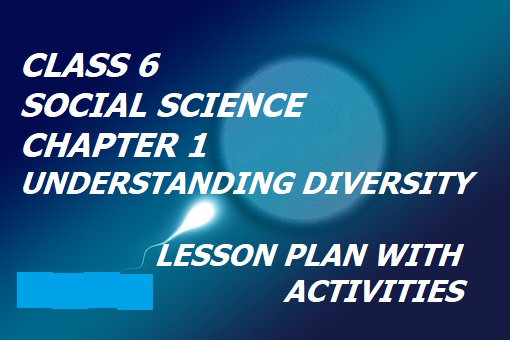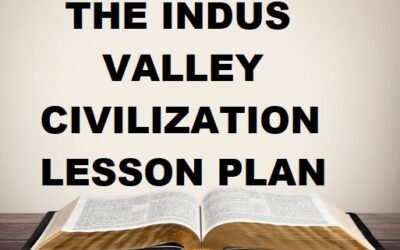Class VI Civics Chapter 1 Understanding Diversity Lesson Plan
Class VI Civics Chapter 1 Understanding Diversity Lesson Plan
General Objective:
Firstly, to develop an interest in the subject.
Secondly, to develop the ability to ask questions.
Finally, developing scientific thinking among the students.
Specific Objective:
Checking Previous Knowledge:
At first, the teacher checks the previous knowledge of the students by asking a question.
Here are some questions that a teacher can use to check students’ prior knowledge about understanding diversity:
- What does diversity mean to you?
- Can you name some examples of diversity you have experienced in your life?
- How do you think diversity enriches our society and culture?
- Have you ever felt excluded or treated differently because of your race, gender, religion, or culture?
- What are some stereotypes you have heard about different groups of people?
- Can you describe a time when you interacted with someone from a different cultural background than your own? How did you feel? What did you learn?
Introducing Topic:
Now, the teacher introduces the topic by asking basic questions like:
Teacher: What are the different languages spoken in India?
Student’s response: Hindi, Bengali, Tamil, Marathi, Punjabi, Malayalam
Teacher: What are the different festivals celebrated in India?
Student’s answer: Ganesh Puja, Moharram, Id, Christmas, Guru Nanak, Bodh and Mahavir Jayanti.
Teacher: What is the traditional dress of Punjab?
Student’s answer: Long Kurta and Lungi with a turban for men and salwar kameez for women.
Teacher: Idli, Dosa is the traditional food of which state?
Student’s response: Andhra Pradesh, Tamil Nadu, Kerala.
Teacher: Bihu is the dance of which state?
Student’s response: Assam
Teacher: What do all these indicate?
Students are unable to answer this question.
Statement of Topic
Now, the teacher will announce the topic.
Today we are going to study Understanding Diversity.
Class VI Civics Chapter 1 Understanding Diversity Lesson Plan
Teaching Method:
While teaching understanding diversity, the teacher will use a teaching methodology that promotes inclusivity and encourages students to
participate. Here are some teaching methodologies that will be followed:
- use diverse perspectives and materials in their teaching to ensure all students feel valued.
- will use cooperative learning to promote social interaction among students from diverse backgrounds.
- also use a method which will foster critical thinking and promote problem solving and creativity.
- activities that will encourage students to explore and appreciate diversity.
Class VI Civics Chapter 1 Understanding Diversity Lesson Plan
Teaching aids:
Text Book, Black Board, smart board, Globe, PPT.
Content/ Teaching Points
Introduction to Diversity:
The chapter introduces students to the concept of diversity and explains that diversity is the differences that exist between individuals and
communities in terms of culture, language, religion, customs, etc.
Diversity in India:
The chapter discusses the diversity that exists in India, including the various religions, languages, and cultures.
Students learn about the diversity of the Indian population and how it has evolved over time.
Celebrating Diversity:
The chapter emphasizes the importance of celebrating diversity and respecting differences.
Students learn that diversity is not a problem but an asset that enriches society.
Stereotyping:
The chapter explains how stereotyping can lead to prejudice and discrimination.
Students learn how to recognize and challenge stereotypes that perpetuate discrimination.
Accepting Differences:
The chapter encourages students to accept differences and appreciate diversity.
Students learn that everyone has the right to be respected and valued for who they are, regardless of their differences.
Role of Education:
The chapter emphasizes the role of education in promoting diversity and equality.
Students learn that education can help create a society that values diversity and promotes social justice.
Overall, the teaching points from Class 6 Chapter 1 of NCERT’s Understanding Diversity emphasize the importance of respecting and
celebrating diversity, challenging stereotypes, and promoting inclusivity in society.
Class VI Civics Chapter 1 Understanding Diversity Lesson Plan
Activities To Be Conducted: Class VI Civics Chapter 1
Here are four classroom activities that you can conduct to teach an understanding of diversity:
Activity 1: Cultural Potluck:
In this activity, the teacher will ask students to bring in a dish that represents their cultural background or ethnicity.
Encourage them to share the history behind the dish and how it relates to their culture.
This activity will not only promote diversity in the classroom, but it will also expose students to different cuisines and traditions.
Activity 2: Diversity Wheel:
The teacher will create a diversity wheel by drawing a circle and dividing it into sections that represent different aspects of diversity, such as
race, ethnicity, gender, religion, language, and abilities.
Ask students to fill in each section with examples of people they know or admire who belong to that category.
This activity will help students understand that diversity is not limited to just one aspect of a person’s identity.
Activity 3 Stereotype Quiz:
In this activity, the teacher Creates a quiz that challenges students’ assumptions about different groups of people.
Ask questions such as “Are all Asians good at math?” or “Do all Muslims wear hijabs?” and discuss why these stereotypes are harmful and
inaccurate.
This activity will encourage students to think critically about their beliefs and assumptions.
Activity 4 Privilege Walk:
In this activity, the teacher will divide the class into two groups and have them stand in two lines facing each other.
He/she will read out statements that relate to privilege, such as “If you have never been discriminated against because of your race, take one
step forward” or “If you have never worried about where your next meal will come from, take one step forward.” This activity will help
students understand how privilege can affect a person’s opportunities and experiences in life.
Assessment Criteria:
During the classroom activity, the teacher will observe and assess the performance of students in the following parameters.
Indicators
- Relevance of Content
- Participation / Performance of information gathered
- Awareness of the information gathered
- Creativeness
- Analytical Skills
Classwork: Class VI Civics Chapter 1
i) Initially, short answer type questions will be done.
ii) Later on, Long answer type questions will be discussed and done in the class.
Homework:
Make a collage to show Unity in Diversity in India.
Values imparted:
- To respect differences.
- Understanding the problems of being discriminated against on the basis of caste, sex, religion, language, etc.
Multidisciplinary Integrated learning:
- Hindi and English: Write about the role of Nelson Mandela’s fight against apartheid.
- Music: Find songs from Bollywood that promote unity in diversity.
- History: Find out why Ambedkar changed his religion.
- Biology: Find out what factors are responsible for the color of our skin.
Class VI Civics Chapter 1 Understanding Diversity Lesson Plan
Learning Outcome:
After the completion of this chapter, students will be able to
Teaching understanding diversity can have a range of learning outcomes for students, here are five possible ones:
Increased Empathy:
Students will learn to appreciate and value diversity in all its forms, which can lead to greater empathy and compassion for others who may
be different from themselves.
Enhanced Critical Thinking:
Students will develop critical thinking skills as they analyze and question stereotypes, biases, and assumptions that they may have held
previously.
Improved Social Skills:
Students will learn how to communicate and interact respectfully with people from different cultural backgrounds, which can improve their
social skills and enhance their ability to collaborate and work with others.
Increased Cultural Awareness:
Students will develop a deeper understanding and appreciation of different cultures, traditions, and customs, which can broaden their
perspectives and help them become more culturally aware and sensitive.
Greater Tolerance:
Students will learn to tolerate and accept differences in others, which can lead to a more inclusive and supportive classroom and school
environment.
This can also help students develop a sense of social responsibility and become more engaged citizens in their communities
Class VI Civics Chapter 1 Understanding Diversity Lesson Plan
Remedial Measure:
Extra Class
The teacher asks the slow learners to stay after school hours for personal attention.
You may be interested in:
Class VI Civics Chapter 2 Lesson Plan
Class VI History Chapter 2 Lesson Plan – As Per NCF





0 Comments